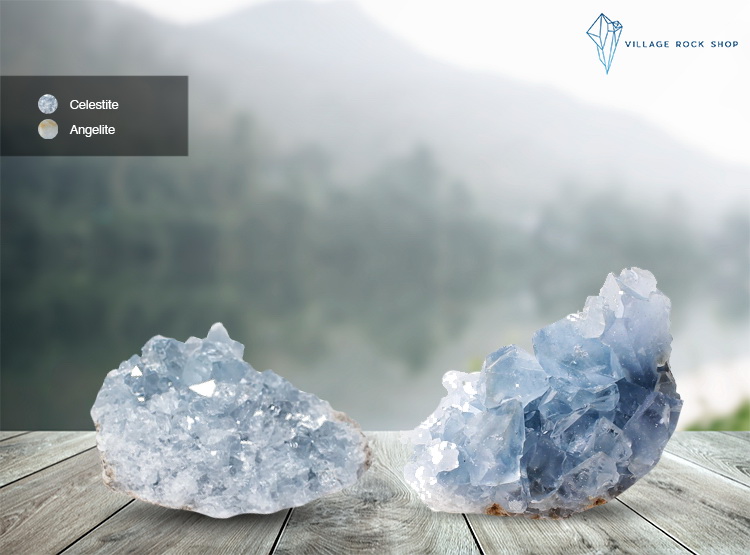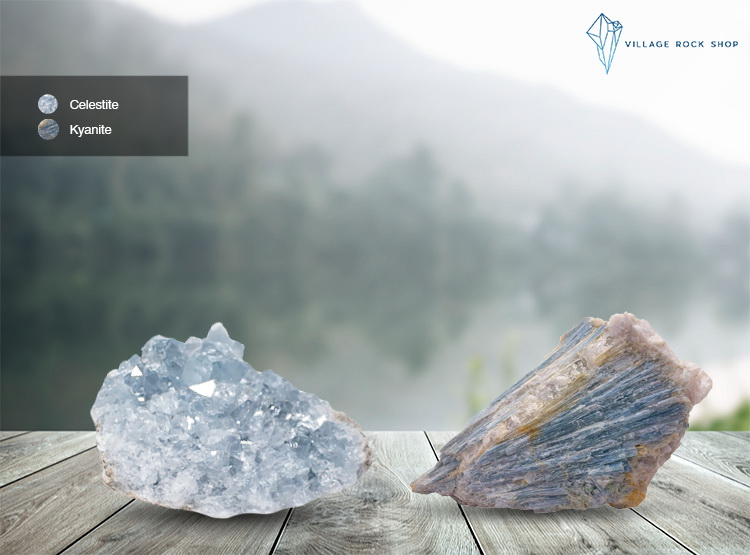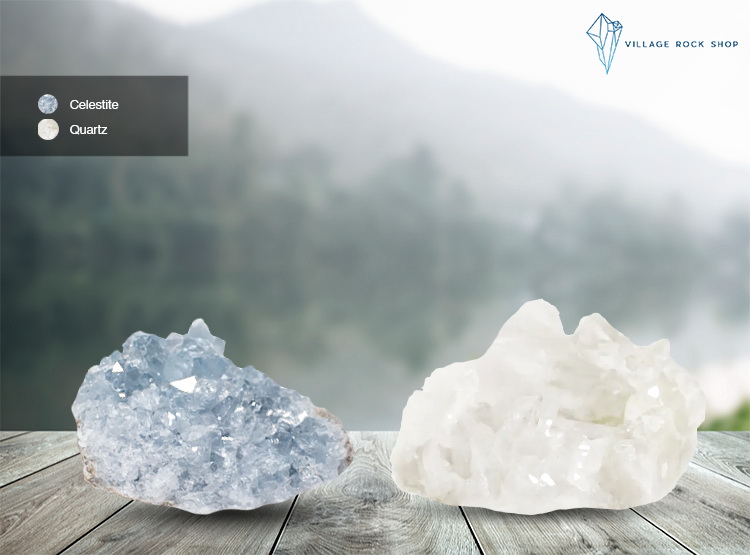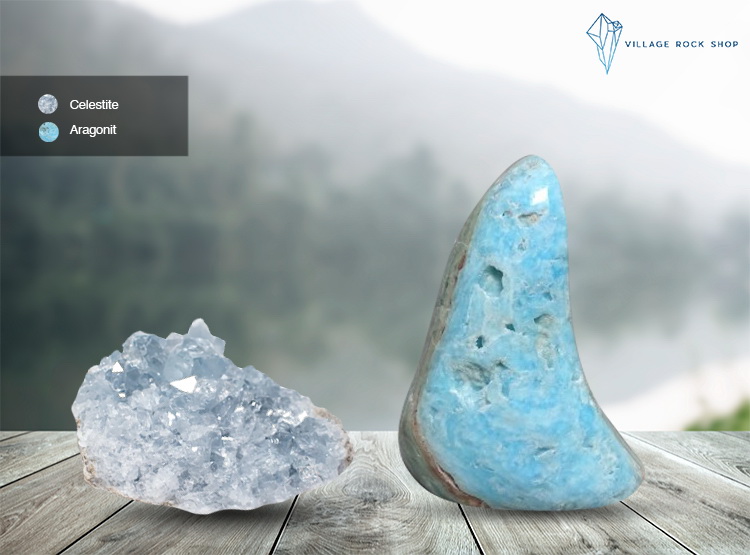Difference Between Celestite and Other Similar Crystals

Celestite is a beautiful light blue crystal, valued for its metaphysical properties. When you visit our shop you'll find a variety of beautiful blue stones with similar properties and benefits like:
- Blue Calcite
- Celestite
- Kyanite
- Angelite
- Aragonite
- Aquamarine
What are the differences between these minerals? What makes them unique?
Celestite or Celestine - There is no difference between Celestite and Celestine. The names Celestite and Celestine refer to the same mineral and can be used interchangeably.
The name of this crystal, inspired by its sky blue shades, derives from the Latin "caelestis" meaning "celestial or heavenly". Celestine is associated with the Third Eye and helps to achieve high states of consciousness, wisdom, and intuition.
Celestite Vs. Angelite

- Mineral hardness: both Celestite and Angelite are fragile with a Mohr scale hardness of only 3 to 3.5. Do not leave these minerals in direct sunlight for a longer period and don't immerse them in water, they will be damaged.
- Different shapes and colors: Both minerals' colors can range from colorless to pale blue, white, pink, light brown, or gray.
- Different chemical compositions: Celestite and Angelite are both crystals with blue shades with similar chemical compositions and similar metaphysical properties. However, they are different minerals. Angelite is Anhydrite ( CaSO4) mined from Peru. Celestite is strontium sulfate (SrSO4) mined mostly in Madagascar, Peru, Egypt, Poland, Mexico, the UK, and the US.
- Meaning and benefits: Celestite is used to connect with spiritual realms, and Angelite is used mostly to connect with the angelic realms. Celestite is associated with the Third Eye, and Angelite with the Throat chakra.
Celestite Vs. Blue Calcite

- Mineral hardness: both Celestite and Celestite are fragile with 3-3.5 hardness on the Mohs scale.
- Shape and color: it can be difficult telling the difference between blue calcite and celestite because they look very similar. The easiest way to tell the difference is the weight, Celestite is the heavier one. On average, Celestite weighs 1.5 times more than Blue Calcite.
- Chemical Composition: Celestite is a sulfate of strontium, being a member of the barite group, while Calcite is a calcium carbonate being part of the calcite group. All forms of Calcite originate in the Earth's ancient oceans.
- Benefits and Properties: Celestite has pure energy and makes it easier to connect to the angelic realms. It brings peace and clarity, calms, and harmonizes the emotional level. Blue Calcite is also valued for its metaphysical properties and enhances psychic abilities. Raw Blue Calcite stones have a calming effect on mental and emotional levels and help in creating and maintaining a harmonious balance between these two levels.
Celestite Vs. Kyanite

- Mineral hardness: While Celestite is known as a fragile mineral with only 3-3.5 hardness on the Mohs scale, Kyanite's hardness is variable from 4.5 - 5 when it's tested parallel to the length of a crystal and 6.5 - 7 when tested across the short dimension of the mineral.
- Shape and color: Kyanite often occurs as long, blue striated bladed crystals colored in white, gray, pink, orange, and yellow shades. Both Celestite and Kyanite are appreciated due to their beautiful blue color.
- Chemical Composition: Kyanite is an aluminum silicate, and Celestite is a sulfate of strontium.
- Benefits and Properties: Blue Kyanite never needs to be cleansed and it's used to clear other crystals. Kyanite is associated with the Throat chakra and Third Eye. It is used in meditations to help to enter deep meditative states. Celestite is associated with the Third Eye and is used for meditations and prayers. Its high vibrational energy makes the connection with the spiritual realms easier.
Celestite Vs. Quartz

- Different shapes: Celestite and Quartz Crystals have different shapes. Quartz typically forms hexagonal prisms terminated with six-sided pyramids at the end of the crystals. Celestite appears in orthorhombic structures and forms granular and fibrous masses.
- Different chemical compositions: Celestite is sulfate strontium, while the Quartz crystals are composed of silicon and oxygen atoms, SiO2.
- Mineral hardness: Quartz crystal's hardness is 7 on the Mohs scale, while Celestite is known for its fragile structure with 3-3.5 on the Mohs hardness scale. Celestite can be damaged by long-term contact with water, Quartz crystals can be immersed and cleansed in water.
- Benefits and properties: Quartz crystals are some of the most versatile crystals. They are used for a large number of purposes including healing, protection, and amplifying the other crystals' energy.
Celestite Vs. Aragonite

Aragonite is a building block of coral reefs and has an essential role in sustaining life there.
- Mineral hardness: Both Celestite and Aragonite are soft, fragile minerals. Aragonite's hardness varies between 3-4 on the Mohs hardness scale. Both minerals can be damaged by long-term contact with water.
- Different shapes: Celestite and Aragonite have distinctively different shapes. Aragonite forms needlelike crystals, while Celestite has an orthorhombic structure and forms granular and fibrous masses.
- They have different chemical compositions: Aragonite has the chemical formula: CaCO3 and Celestite has SrSO4.
- Benefits and properties: Aragonite helps in transforming emotions like anger, resentment, and frustration. The mineral boosts self-confidence and self-worth. It can help in stress relief and brings patience to its owner. Celestite brings a sense of serenity and inner peace.
Celestite Vs Aquamarine

- Mineral hardness: Aquamarine is a hard mineral with 7.5-8 on the Mohs scale, it is much harder than Celestite.
- Chemical composition: Aquamarine is Beryllium Aluminum Silicate, Be3Al2(Si16O18), and crystallizes in the hexagonal system.
- Shape and color: Aquamarine has a translucent light turquoise color and it's associated with the water element, this makes it an ideal mineral for gem essences.
- Benefits and properties: Aquamarine being associated with water, has a cooling effect on the whole being. We recommend placing an Aquamarine over tensed or painful areas of the body. The soothing energy of this mineral will aid in the healing process. Aquamarine opens and activates the Heart and the Throat chakras. While Aquamarine has a strong resonance with the water element, Celestite as the name suggests has a profound connection with high-vibrational astral realms.
Beautiful Crystals at the Village Rock Shop
It does not matter which crystals or gemstones you prefer, all of them will bring a lot of wonderful benefits to you.
At the Village Rock Shop, we recommend combining these gemstones for enhanced, more powerful results.
We invite you to visit our shop based in Carlsbad to check out our rich collection of minerals for your own benefit.
If you are not able to find what you are looking for we are happy to order it for you.

